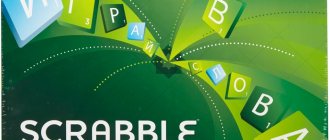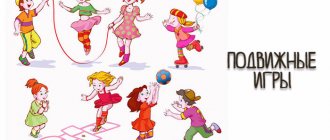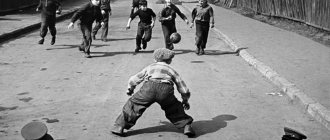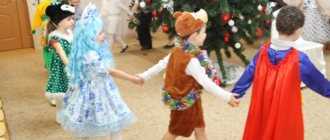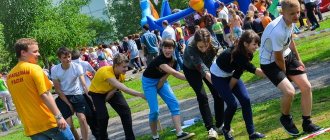Here you will find the most popular and common sports games for adults, as well as their detailed descriptions. To do this, go to the appropriate pages:
- American football Air hockey Bike polo Fast badminton Water polo Volleyball Disc golf Korfball Laser tag Lacrosse Lacrosse part 2 Mini golf Mini football Paintball Petanque Beach handball City reconnaissance Racquetball Rugby Regball Squash Sports relay races Hardball Bandy Frisbee Flag - football
Currently, there are a large number of team sports in which adults can take part. Unfortunately, even children in the age of computer technology cannot be forced to do anything more active than virtual battles. The same misfortune befell adults - many quite serious citizens prefer conquering castles and lands in an online toy to active recreation. A good replacement for such games can be found on the website in the “Intellectual Games”
.
Or perhaps they simply do not know about the beneficial effects that sport can have on the body and quality of life. Of course, few people like tedious exercises, so sports games for adults remain the best option for keeping the body in good shape.
Slippery rope
Guests are divided into 2 teams of approximately 3-5 participants. The leader hands the teams a rope (one team on one side, the other on the other). But the rope must be lubricated with oil or Vaseline in advance. Before the start, all participants also lubricate their hands with oil or Vaseline. Members of both teams must have the same position in relation to the rope. At the command “start” the participants begin to tug of war. The team that manages to pull the slippery rope to its side, beating its opponents, will be the winner.
Team building games for students; methodological development for physical education (grade 5) on the topic
Classification of team building games
1. Low mobility games
- Without a mask
- Balloon
- Braggarts Competition
- Magic bag
- I am looking for a friend
- Polite words
- Who cares what
- We share according to criteria
- Counting to 10
- Throw it on your fingers
- Count to 18
- Nuts
- To my neighbor
- Typewriter
- Pace
- Pulse
- North South West East
- Observers
- Joystick
- Quiet-louder
- Mathematics
2. Games with motor activity (BI)
- Centipede
- Kite
- Velcro
- Nodules
- All aboard
- Walk of the Blind
- Electrical circuit
- Big Mac
- sitting circle
- Push ups
- Trust foul
- Sorcerers
- Sculptural portrait
- Prostitute
- Foggy Harbor
- Lenin's grandfather's log
- Flashing lights
- Dangerous reefs
3. Games with physical activity (MA)
- Web
- Crossing
- Electric fence
- Log
- Crane
- Find the ball
- Trolls
- All aboard
- Compliment
- Laser wall
- Poisonous flow
- Landing pad
- Knot
- Plates
- Ant trail
- Rope
- Octopussy
- Find the ball
Distribution of team building tools across curriculum sections
| № | Name of program sections | ||
| Gymnastics | Athletics | Sport games | |
| Nodules | Sorcerers | Big Mac | |
| Push ups | Push ups | Sorcerers | |
| Trust foul | Electric fence | Foggy Harbor | |
| Sculptural portrait | Web | Prostitute | |
| All aboard | Centipede | Find the ball | |
| Log | Flashing lights | Dangerous reefs | |
| Trolls | Counting to ten | North South West East | |
| Web | Joystick | Observers | |
| Laser wall | Quiet-Louder | Landing pad | |
| Landing pad | Pace | We share according to criteria | |
| Ant trail | Pulse | Mathematics | |
| Rope | Typewriter | Compliment | |
| Lenin's grandfather's log | sitting circle | Poisonous flow | |
| Knot | Centipede | Octopussy | |
| Exit by number of fingers | Plates | ||
| Flashing lights | |||
| Throw it on your fingers | |||
| Nuts | |||
| Football for octopuses | |||
List of team building games used during physical education lessons
"Knots".
Participants form a circle and join hands, with the hands of one person clasped with the hands of different people. Task: without releasing your hands, unravel the knot and form a circle.
* This exercise provides an opportunity for everyone to participate in strategy development.
"Electrical circuit".
The team is divided into pairs. The partners sit opposite each other, where they connect their hands and feet, thus forming an electrical circuit through which current flows through the clasped hands and feet. The participants’ task is to stand up without breaking the electrical circuit. Now combine two pairs with each other to make an electrical circuit consisting of four people. The task remains the same - to stand together without breaking the chain. When this stage is safely completed, combine the groups again to form an electrical circuit of 8 people. In the end you will have an electrical circuit formed by all the participants that must rise.
Two main conditions for this exercise: 1) electric current must flow unhindered through a closed electrical circuit formed by clasped hands and feet; 2) at each stage, participants must leave the ground at the same time.
Tip for the counselor: don’t forget to support the children, because it’s very difficult for them!
"Big Mac".
Organize a big circle. Divide the team into pairs and ask each pair to choose a phrase from two words that are traditionally used together (for example, one partner says: “Big,” the other: “Poppy,” one: “Nut,” the other: “Butter,” etc.) .d.). Then explain that according to the rules of the game, you need to close your eyes and not open them until the end of the event, and, in addition, you can only say your chosen word. Now the leader shuffles the team so that the partners are far from each other. Partners with their eyes closed, shouting their word, find each other. Once the couple is reunited, move them out of the way of those whose eyes are still closed. Upon completion of the task, each pair tells all participants their word combination.
For this exercise, the platform plays a very important role, which should be large.
"Sitting circle"
The team forms a tight circle (shoulders touching). After this, ask the guys to turn 90 degrees to the right. Task: You need to slowly sit on each other’s laps and touch the shoulder of the person behind you with your hand.
End this exercise on a high note with everyone laughing and clapping.
"Push ups".
Break into groups of 4 people. Your task is to push up from the ground so that only your hands rest on it, and hold on for at least 5 seconds.
* Tip for the counselor: it will be most convenient to perform push-ups if the group lies face down on the ground so that a square is formed, the sides of which are formed by the bodies (the legs of one lie on the back of the neighbor).
The counselor needs to ask the children if they have back problems? In this exercise, such children can be involved as judges.
"All aboard."
Equipment: any designated area (banquette, chair, block).
The participants' task is to fit the whole team into a medium-sized area. You need to remove both feet from the ground and hold for at least five seconds. Second stage: you need to do the same on a smaller area.
"Log".
Equipment: any beam (a tree lying on the ground, a gymnastic beam, etc.).
The team lines up on a log. Starting with the first person, the team moves to the opposite end of the log. The result should be the same line, in the same order.
* Tip for the counselor: it is better to arrange the team, alternating boys and girls.
"Trolls"
Equipment: trolls - a small board, block or other auxiliary object.
Mark two parallel lines located at a distance of at least three meters from each other. The team's task is to cross from one line to another without touching the ground, using trolls.
"Walk of the Blind"
Have each participant cover their eyes with a blindfold. When all eyes are closed, tell the guys that we are going on a journey through an inviolable land that our gaze cannot touch. Ask to place your right hand on the shoulder of the person in front. Slowly begin your journey along the chosen route, including climbing stumps, hills, crawling under low-hanging trees and branches, squeezing between trees, etc. Finish in some cramped (but safe!) place.
* Tip for the counselor: this exercise should be performed in complete silence. You should choose a sign to indicate danger (shrug, tap on the shoulder, etc.).
"Web".
Equipment: a “web” pre-woven from ropes. The number of cells must correspond to the number of participants. The task is to cross the entire team through the web from one side to the other without touching any part of it. If you touch the web, the whole team goes back and starts the exercise again. If one of you crossed to the other side, then he cannot return, bypassing the web, and help the team. Each cell can only be used once.
"Crossing".
Equipment: rope, bucket of water. A “pendulum” is prepared in advance (the rope is attached to a support).
The task is to cross the entire team beyond the designated line without touching the ground. In addition, each team member needs to carry a container of water without spilling a single drop.
Insurance required!
"Electric fence."
Equipment: rope, pole (board, stick, etc.).
The goal is to get the whole team over an imaginary electrical wall without touching any visible or imaginary part of it. If anyone touches the wall, the whole team goes back and starts the exercise again.
* Tip for the counselor: the pole can be used by the whole team or by the last participant.
“Trust is a foul.”
Line up your team in two lines with both groups facing each other. Ask them to take off their watches, rings, bracelets, stretch their arms forward, bend them at the elbows (90 degree angle). The hands alternate with each other, forming a “cradle” for the falling one. The palms are facing upward and in no case are clasped either with each other or with the hands of a neighbor on the side or opposite. The belayer's knees are slightly bent. The leader stands in a line at the place where the greatest weight of the falling person will fall and, no matter what happens, do not remove his hands while the participant is falling. Place strong guys next to you. As the line progresses, you can change the order of the line so that each participant experiences the moment of the catch, but keep the strong ones in the middle.
If you have a large strong team, you can be the leader of the fall (outside the line), but if you feel that the team needs you for the safety of the fall, ask the guys to choose a leader (Maestro) themselves.
Prepare the Maestro so that he can check the falling one.
• The torso and legs must be absolutely straight, like a string;
• Hands - crossed on the chest and clasped;
• The head is slightly thrown back;
• Ask to remove glasses and remove items from pockets.
Words that must be said before falling:
1) FALLER: “Are the belayers ready?”
2) INSURED: “Insurers are ready”
3) MAESTRO: “Fall.”
After landing, rock your friend in your arms - show affection.
Conclusion: This is an exercise in trust and releasing inhibitions (releasing the inner self). Ask everyone to share their experiences and feelings, as everyone's feelings are individual. Start the discussion by saying what you would like to know about everyone's feelings:
— How did you feel just before the fall began, during the fall and after?
— What can be done to create a trusting atmosphere in the team?
Base your discussion on your experience.
Compliments
The players stand in a circle and throw the ball to each other in random order. The throw should be accompanied by a compliment to the person to whom the ball is thrown.
The bigger the ball, the better - it makes people open up.
Sorcerers.
The players stand in a circle with their eyes closed, after which the leader, touching the shoulder, appoints two or three of them as sorcerers. Then everyone opens their eyes and begins to make a chaotic movement, shaking each other's hands. Each of the sorcerers can (but is not obliged!), when shaking hands, to bewitch the player whose hand he is shaking by quietly scratching his palm. The bewitched person, having shaken hands with someone two more times, goes to the corner for the bewitched (leaves the game). The task of the non-sorcerer players, looking closely at each other, is to expose all the sorcerers; the task of those, in turn, is to bewitch everyone.
Who cares what
Two teams:
1.In 1 min. Show proverb. Your team guesses.
2.Draw on the topic. (Drink). Your team guesses.
3. Compose a story with a string. Each team is given 2 keywords. One of which must be the last.
4. Topic: "...". Guess as many words as possible (in 1 minute) that a player from your team said before
We share according to criteria
One person goes out the door, while the group agrees on how to divide and splits into two groups (for example, those who have laces and those who do not). The newcomer’s task is to guess on what basis the group is divided into two parts.
Counting to ten
“Now, at the signal “start,” you will close your eyes, lower your noses down and try to count from one to ten. But the trick is that you will count together. Someone will say “one”, another person will say “two”, a third will say “three” and so on... However, there is one rule in the game: only one person must say the word. If two voices say “four,” the count starts over. Try to understand each other without words.” did the group manage to do it? If yes, then how? If it didn't work out, then why? What was stopping you? Who took an active part, who remained silent?
Sculptural portrait
One of the participants is volunteered (or chosen by the group - this is even more interesting, because it shows whose opinion and vision, whose feedback the group members primarily want to receive) to be a “sculptor” who will have to immortalize the group in a “monumental sculpture”. Each character in the sculptural group should have its own role, its own function. The sculpture of the group should somehow be “embodied in stone,” and perhaps in some other material, which will help highlight the role of each. “You are a sculptor. So embody what you see, how you feel. We will be your material - the sculpture will consist of us. Put us in different poses, mold and “carve” whatever you want out of us. And then you’ll tell me what you wanted to say with your work.” The sculptor begins to work. The “sculptures” may turn out different: it all depends on what the situation is in the group and how the participant sees it. For example, the presenter can be placed on a chair, at his feet the participants who unconditionally follow him and raise their eyes to him can be built, someone can be behind the chair on the periphery of the sculptural group and, with fingers attached to their eyes in the form of binoculars, etc. Then follows “sculptor’s” comment. He says what he had in mind, giving this or that participant the appropriate pose, choosing for him certain roles in which they were seen. Several such “sculptural portraits” may be made by different participants.
Prostitute
Everyone joins hands, standing in a circle and begins to get confused. When everyone got confused and it turned out to be one big “confusion,” one can imagine that the whole group turned into one huge beast. Now it is urgent to determine where his head is and where his tail is. (“Who will be the head? And who will be the tail?” asks the presenter). When the animal has become oriented where its right is and where its left is, it must learn to move in all directions, including backwards. And then, the animal must run through, and maybe even “eat” someone it gets along the way.
Flashing lights
Representatives of the same sex (for example, girls) sit in a circle on chairs facing inward, one seat is free. Representatives of the other sex, for example, young people, stand behind the backs of chairs, one at a time (including an empty one) and keep their hands at their sides. One of the participants who stands behind an empty chair tries to lure one of those sitting to his chair by winking at him (in our example, at her). When someone sitting tries to run to an empty chair, the task of the one standing behind him is to prevent him from doing this, that is, to carefully catch him and not let him go.
Laser barrier
The path you are following is blocked by a 1.5 meter high laser wall, and there is no way for you to get around it. You must get over this wall as a group "safe and sound." The group can only use themselves and a 2.5 meter long beam (beam) as a means of assistance. The top edge of the laser beam can be indicated by a rope stretched at a height of 1.5 meters between trees or two players in the game.
Foggy Harbor
The team must navigate an oil tanker (one of the team members) without colliding with other vessels (the rest of the team). The “tanker” must be blindfolded, its task is not to run into other ships on its way, standing all over the playing area. As soon as the tanker on all fours approaches, the nearest “ship” begins to sound a warning signal (like a siren). Then the “tanker” slows down and tries to maneuver in order to pass through the harbor without collisions.
Poisonous chemical flow
The group must navigate a stream of toxic chemicals using a limited number of available tools. Team members are not allowed to touch the ground. Materials: 5-10 tin cans, 2 two-meter poles, 3 boards. Tin cans and poles are chemical resistant, boards are not.
Landing pad
By completing the following task, you can see how many people can fit on an area measuring one meter by one meter. Participants get there from a certain point located at a distance of 5-6 meters, hanging and swinging on a rope.
The platform should be located three meters from the vertical line of the freely hanging rope (this distance depends on the length of the rope and the height at which it is suspended).
Make a few trial runs to determine the exact location of the area and starting line. To complicate the task, place a stick on two tin cans and place it directly in front of the starting point: if someone carelessly knocks over this stick, the whole group completes the task again.
If you have played or seen bowling, you can imagine what happens when a large number of people can hardly fit into a small space, and then another one flies towards them on a rope.
Lenin's grandfather's log
The group lies on the floor, one person perpendicular to the top, the task is to jointly move him from the beginning of the row to the end. You can't help with your hands.
Exit by number of fingers
The group stands in a line. The presenter calls a number not exceeding the number of people in the group. Immediately a number of people equal to the named number should jump out of the group. The exercise is repeated until the result is achieved, each time with a new number. There is a feeling of being able to understand each other without words.
Throw it on your fingers
The whole group needs to throw out numbers on their fingers on “one-two-three” so that their sum is equal to the one set by the leader. The exercise is repeated until the result is achieved.
Count to 18
The group must count in order to a number that is either equal to or greater than the number of participants, with only one person saying each number. It is impossible to agree on who says what. As soon as several people say a number at the same time or no one says it for a long time, the counting starts all over again. Optional Rule: Each person must say at least one number.
Knot
Each member of the group holds onto a rope. The task is to tie the rope into a knot. You cannot let go of your hands, you can only move them along the rope (if someone lets go of their hands, the exercise starts over).
Option 1: then untie the knot with the same rules.
Option 2: untie the knot tied by the leader.
Plates
The group is given several plates. The group must, without stepping on the carpet, cross it on small plates. Condition: at least one leg must be on each plate at all times, otherwise the plate is taken away.
Ant trail
The group splits into two and stands on a long board on either side of the middle. The task is for two subgroups to switch places. If someone steps on or touches the ground, the exercise starts over.
Rope
The rope is stretched just below the waist of the tallest person in the group. The group stands holding hands. The task is for everyone to pass over the rope without touching it.
Note. In order for group work to proceed, restrictions should be introduced: jumping, talking is prohibited.
Octopussy
Long strings are tied to the ring, and a tennis ball is placed in the ring. The task is to carry the ball around the column without dropping it (carry it over the field).
Option: a balloon in a large ring.
Nuts
Each person in the group is given a walnut. It is necessary to carefully examine it and remember it. Then the nuts are put into a common pile and mixed (you can add more nuts to make it more complicated). Everyone must find their nut. A more difficult option is the same with your eyes closed. Then everyone in a circle is asked how he identified his nut. The counselor’s task is to conduct a discussion: at first glance, all nuts seem the same, but in fact they are very different, just like people. Each person is individual, and in order for this individuality to reveal itself, it is important to treat people attentively and kindly.
Find the ball
The players stand in a circle close to each other, facing the center, holding their hands behind their backs. The driver stands in the center. At the signal, children pass a small ball behind their back. The driver tries to find who has the ball: he offers to show his hands. The one to whom the driver addressed immediately extends both hands forward. The one who has the ball in his hands or who drops it is considered the loser.
Flashing lights
Children stand in two circles - inner and outer, facing the center of the circle. This is how pairs are formed: one - from the inner circle - stands with his back to his partner and looks at the driver; the other - from the outer circle - stands behind him at a distance of half a step, looks at his heels, holds his hands behind his back. The driver is in the center of the inner circle (without a couple), he winks at someone from the inner circle. Seeing that they winked at him, the player in the inner circle tries to run away. If the partner manages to hold him back, the driver winks at the other player, and if not, then the one who ran away stands behind the driver, and the player who missed his partner becomes the driver.
To yourself - to your neighbor
Children stand in a circle. The left hand is held extended forward, with the palm open upward, the right hand - palm down with a pinch (as if they are holding something in it). When they say “to themselves,” the children use their right hands to seem to put something into their left hand. In response to the word “neighbor,” they “put” something with their right hand into the left hand of the neighbor on the right. All. simultaneously perform the movements and say: “To yourself - to your neighbor.” In fact, a small object (a coin or a pebble) is passed around in a circle. The leader (in the center of the circle) must notice who has the coin. When he succeeds, he and the player whose coin was found switch places.
Typewriter
The game teaches concentration, composure, and develops the ability to act as a group. Players take turns calling each letter of the alphabet, remembering the letters they received. The presenter suggests printing a telegram with a certain text. For example: “I’m going. Meet me. Dwarf". Before the beginning and at the end of the phrase, the whole group must clap their hands twice. Then the one who got the first letter of the telegram claps once, “printing the letter”, followed by the one who got the second letter, etc. After the word is “printed”, the whole group makes one clap, thus separating words from each other.
The game continues until the group transmits the entire telegram “Typewriter” is carried out silently.
Pace
Like the previous one, this game promotes concentration and develops the ability to act as a group, but is played more dynamically and energetically. All players sit in a circle, settle in order and remember their numbers. The presenter sets the pace: two claps on the knees, two snaps of the fingers. Everyone repeats. As soon as a single rhythm can be established, words are introduced. Hitting the knees twice, the presenter says his number twice: “One, one” and makes two clicks with his fingers; then, slapping his knees the first time, he says his number, after the second, he says the number of the player to whom he passes the word, for example: “One, three.” Now player number 3, without leaving the general tempo, leads the game. It is advisable at the beginning of the game to simply pass the word one by one so that the players remember the tempo and rules of the game, and then do it at random, gradually speeding up the pace.
Pulse
Timed game. Standing in a circle and holding hands, players (10-50 people) try to convey the “impulse” as quickly as possible by squeezing the hand of the neighbor on the right. Try playing the game first with your eyes open and then with your eyes closed. Compare the times. Now ask one of the participants to send a “pulse” in two directions. See if the “pulses” can intersect and continue their course further. Similar to an impulse, anything can be transmitted, for example, sound or a word.
North South West East
10-15 people play, lined up in two lines and separated by one step. The leader indicates to the players the sides of the horizon: north, south, west, east. Then he loudly calls any side of the horizon, for example north, and all players must quickly and clearly make a turn, facing the north. Whoever makes a mistake receives a penalty point. The one who receives fewer penalty points wins.
Observers
For a minute, the children carefully examine the objects presented by the teacher, and then turn their backs to him. At this time, objects are changed places or removed. Students must identify changes in the environment.
"Joystick"
The game is a team game (preferably two teams). The teams face each other, with each person taking the hand of his neighbor by the thumb. Your neighbor's thumb will be the joystick. The first in the chain extends his hand forward over the table. What is the coin placed on? Everyone closes their eyes except the last team member. He controls the “joystick”, transmitting the command to the first through the other participants. The goal is to be the first to place your finger exactly on the coin.
Goal: increasing group cohesion, team spirit, competition.
“Quiet-louder”
You probably played the game “Hot or Cold” as a child? Our game is similar to it: the guys sit in a circle, the driver leaves the circle and turns his back. One of the members of the circle has some object hidden. The driver's task is to find the person who has the hidden object. As soon as he enters the circle, everyone begins to sing some kind of song, the louder the closer the driver is to the hidden object. Accordingly, the song is sung more quietly if the driver moves away from this person. When the item is found, the driver changes; if not, then the game continues.
"Mathematics"
Children sit in a circle. The counselor gives the task: “We begin to count in a circle. The one who has a number that is a multiple of three says his name instead of the number.” This game can be used to develop memory and attention. Play and you will see that this is true
"Dangerous Reefs"
For this game, all participants are divided into “reefs” and “ships”. The second leader blindfolds them, so that they can navigate in space only under the guidance of the “reefs” who see everything. The purpose of reefs is to prevent ships from colliding with them.
Team fight in checkers
Not everyone knows how to play chess, but the game of checkers is known to everyone, even children. So, the guests are divided into 2 teams of approximately 5 participants. At the same distance from the teams there is a table (chair), and on it there is a board with checkers placed. Team members stand in a row, one after another. At the command “start”, the first participant of “white” (and this is decided with the help of a coin) jumps on one leg to the board and makes his move, returning back on one leg, after which he stands at the end of the team. After him, the first “black” participant jumps to the board on one leg, makes his move and returns to his team on one leg, standing at its end. Next, the second participant of the “whites” jumps, then the second participant of the “blacks” and so on until the bitter end. The winner will be determined by ingenuity and ability to play checkers. This game combines two types of sports: active and mental. And the winner can be given a mini-set of checkers (pocket checkers), which can be taken with you on any trip in order to while away the time with a companion.
Military sports games
Nowadays, military sports games involving the inclusion of elements of combat tactics have become widespread. Weapons are used here and army methods of moving around the game space are used. Teams are formed according to military principles: squad, platoon, etc. The scope of action is close to that usual for real combat operations - a field, a forest. Teams can conduct defense, attack, reconnaissance. Military sports strategy involves the interaction of team members and creates a combat situation. The group that defeats all members of the opposing team wins.
The following games are the most famous in our time:
Paintball. Rival teams shoot paintballs at each other with air guns. The balls crash against a live target and “mark” the achievement of the goal.
Hardball. This competition uses pneumatic recreational weapons with a bullet speed of 180 meters per second
Laser tag. A laser emitter is used as a weapon, hitting touch sensors.
Airsoft. Weapons - pneumatic and electro-pneumatic with plastic balls (caliber - 6 mm).
Unbalanced swallow
Among the guests, those who want to show their perseverance and endurance are chosen. Near each participant there is a bag with identical objects, for example, a book, a toy car, a teaspoon, a nut, a piece of paper, a pencil, and so on. At the command “start”, all participants take the “swallow” position, and the guests (one guest per participant) begin to place objects on the participants. The presenter directs the process, for example, a book on the left hand, a pencil on the leg, and so on. Whichever participant can pass the test without dropping a single object and holding the stance to the end will be the winner.
For the little ones
For children 1-3 years old, classes in the gym are good. Nursery groups do not use games with competitive elements. All classes in preparatory groups should be health-saving.
Children aged 1-4 years are not yet coordinated, so some fun activities can be dangerous. You need to worry about preventing injuries. The very definition of games for little ones can be briefly formulated: safe, interesting, simple tasks.
For such games, the minimum group is 2-3 children. Meanwhile, music will help you have fun indoors.
The hare treats the bear
Necessary equipment for this game: 2 chairs, a bucket of water, an empty bucket, a mini plastic cup, a bear toy.
Methodology:
- Place the buckets on different chairs at a distance of 2 m from each other. Place a toy near one of the buckets.
- A full bucket is a treat from the hare for the bear
- The bucket next to which the toy is located should be filled halfway with water using a glass in which children carry water.
- The teacher (parent) reads the poem:
The brown bear is one year old,
Let's treat you to compote,
Two cute bunnies
Together with the hippopotamus.
Burner
Required equipment: chair, bucket and spoon.
Methodology:
- Place the bucket on the chair and give the child a spoon.
- The teacher (parent) reads the poem:
We cook national soup,
Cabbage soup is boiling with cabbage,
Bright, cool, useful,
And it’s delicious too!
- The child makes rotational movements with a spoon in a bucket.
The teacher reads:
Spun, spun,
And they stopped interfering!
- The child spins around himself 2 times and gives the spoon to another.
- The game continues until all children have stirred the cabbage soup.
Automobile
Required equipment: 3 chairs.
Methodology:
- Place chairs next to each other.
- The teacher (parent) reads:
I'll go to the river alone,
I'll sit down quickly.
- One of the children sits on a chair, the rest of the children continue to walk. The teacher (parent) reads:
The two of us will go to the river,
Let's invite friends.
- The second child sits on a chair, the remaining child continues to walk. The teacher (parent) reads:
The three of us will go to the river,
It will be more fun!
- The last child sits on the remaining chair. The game is over when all three children are sitting on their chairs.
The schemes are very different, but it is important to take into account age (it may be indicated in the title of the video). The selection of music used during games should be dominated by light classics and children's songs.

